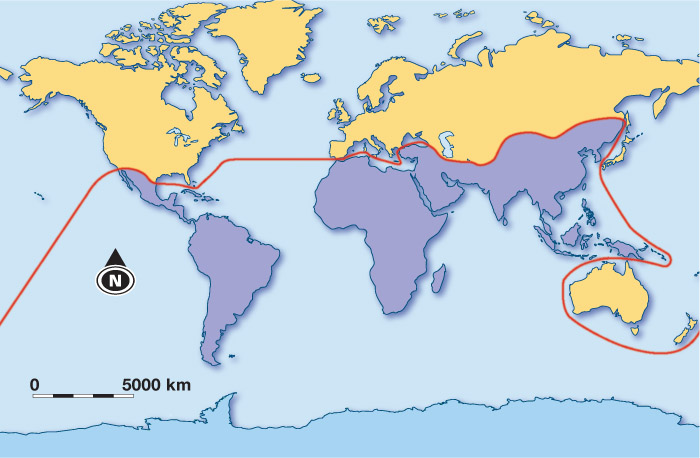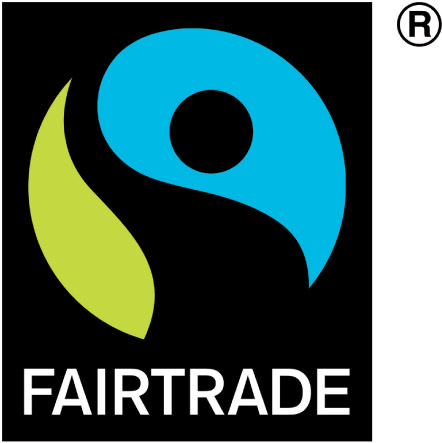7.5 Fair trade
While globalisation and transnational companies are bringing the world together, there is a widening gap between the economically wealthy and the poorer countries of the world.
This gap between the richer and poorer countries is often referred to as the north–south gap or divide.
The north (or developed) countries are mainly in the Northern Hemisphere (North America, Europe and Japan) and are the wealthy countries.
These countries have high levels of industrial development, higher standards of living (in health and education, among other things) and are home to most of the transnational companies.

The south (or developing) countries are mainly in the Southern Hemisphere (South America, Africa and Asia) and are the poorer countries. These countries have less industrial development, lower standards of living and weak workplace protection laws.
DEVELOPING YOUR UNDERSTANDING 7.6
As a class:
- Decide whether Australia is a north country or a south country, and provide your reasons.
- Determine whether China is now part of the north or the south. (Hint: The concept of the north–south gap originated in 1980 and times change.)
- Investigate where the term ‘north–south gap’ was first used: was it by people in the developed countries of the north or by people in the developing countries of the south?
Trade between north and south countries is seen as an essential way to reduce global poverty and close the gap between the rich and poor countries.
Developing countries trade mainly in primary goods (food and raw materials such as minerals and cotton) and labour-intensive manufactured goods such as clothing. There are few controls over working conditions and environmental standards. The prices for their goods are largely set by the importing developed countries.
This raises a question – is trade between the south and north countries fair?
The fair trade movement says that often the trade is not fair as workers, producers and the environment in the developing countries are often mistreated by transnational companies and restrictions are placed on their trade by the developed countries.
Origins of fair trade
The movement towards fair trade has many origins, and goes back to the 1940s. Initially it was mainly people from economically richer (north) countries buying craft work from handicraft workers in developing countries and selling the craft in their local communities.
Edna Byler, from Pennsylvania, in the United States, was disturbed by the poverty levels she saw in the villages she visited in Puerto Rico in 1946. She was impressed by the high quality of the linen needlework done by women in these villages.
She bought some of the needlework and sold it to her friends and neighbours. In 1952 she and her friend Ruth Lederach displayed and sold the needlework at the Mennonite World Conference in Basel, Switzerland. The project became the Overseas Needlepoint and Crafts Project.
In Europe, the fair trade movement began with Oxfam UK. In 1964 Oxfam began marketing handicrafts from developing countries, aiming to give small-scale producers fair prices, training, advice and funding.
The name ‘Oxfam’ comes from the Oxford Committee for Famine Relief, founded in Britain in 1942 during World War II. The group campaigned for food supplies to be sent through an Allied naval blockade to starving women and children in enemy-occupied Greece.
The first fair trade certification and labelling system started in the Netherlands in 1988, with ‘Fairtrade’ labelled coffee from Mexico being sold into Dutch supermarkets under the Max Havelaar brand.
In 1997, Fairtrade International, formerly known as the Fairtrade Labelling Organization (FLO), was established as an umbrella organisation for 20 Fairtrade certification initiatives in Europe, the United States, Canada, Mexico, Japan, Australia and New Zealand. There are currently 586 Fairtrade-certified producer organisations and 469 certified traders in Fairtrade International’s network – including TransFair, Max Havelaar and Fairtrade Foundation – and 1.24 million farmers and farm workers from 66 producing countries. Fairtrade International certifies individual products that bear the blue and green Fairtrade mark (see Source 7.9).
The World Fair Trade Organization (WFTO), formerly the International Federation of Alternative Traders (IFAT), is a separate global network of Fair Trade Organizations. In 2004, WFTO launched its Fair Trade Organization Mark (FTO), through which organisations that meet WFTO’s fair trade standards for working conditions, wages, child labour and environment can receive certification as Fair Trade Organisations. The FTO mark is a company label, or logo, and goes on the company letterhead.
Source 7.7a This video looks at the work of Fairtrade Australia New Zealand. The Fairtrade International FAIRTRADE Mark. (02:13)
Since 2001, starting with Garstang in England, there have been an increasing number of towns, especially in the United Kingdom and the United States, that are committed to following fair trade principles. By the end of 2012 there were 554 fair trade towns listed in the UK, and worldwide there were over 1100 fair trade towns spread across 23 countries.

| Food Products | Non-food products | |
|---|---|---|
| Bananas | Juices | Cotton |
| Cocoa | Nuts/oil seeds and purees | Cut flowers |
| Coffee | Quinoa | Ornamental plants |
| Cotton | Rice | Sports balls |
| Dried fruit | Soya beans and pulses | |
| Fresh fruit and fresh vegetables | Sugar | |
| Herbs and spices | Tea | |
| Honey | Wine | |
Fairtrade certified products are part of a growing ethical certification movement that aims to support consumers in richer countries to purchase products from poorer countries that have been produced under sound social, economic and environmental ethical conditions. For example, UTZ-certified coffee, tea and cocoa are based on acknowledging and supporting more sustainable farming methods, improved conditions and opportunities for farming families, and a sustainable planet now and in the future.
Where to now with fair trade?

The fair trade movement over the past 30 years has done a lot to raise the awareness of consumers in the developed world of the need to improve the working and living conditions of farmers, producers, other workers and their families, and their environment in developing countries. The fair trade movement has also made us aware that we, through our purchasing choices, can be part of the solution.
The success of the fair trade movement can be seen by the mainstream shops and transnational companies joining it. In Australia, supermarkets are now selling some Fairtrade certified products, such as coffee.
In December 2009 Nestlé announced that it would be using Fairtrade certified cocoa in its four-finger KitKats in Britain and Ireland. This was extended to the two-finger KitKats in January 2013.
In Australia KitKats are produced using Rainforest Alliance certified cocoa. For further information on Fairtrade certified and other ethically certified chocolates on sale in Australia, go to www.cambridge.edu.au/hass9weblinks and follow the link to The Good Chocolate Guide to Australia.
The Ethical Consumer Guide also provides information on Fairtrade certified or other ethically certified (or not certified) chocolates on sale in Australia. A web search for a ‘list of fair trade products Australia’ will provide information about the types and sources of other fair trade products available in Australia.
Issues with the fair trade certification of products
Are transnational companies using fair trade certified products because of their commitment to human rights and environmental standards? Or because they see that it is a good way to market their products in places where consumers are committed to ethical buying?
When a fair trade certification or another form of social or environmental ethical certification is used as a marketing tool rather than as a commitment to ethical behaviour, it is referred to as ‘cleanwashing’.
There are now many ethical certifying organisations. For example, coffee can be certified under a number of certification organisations, including UTZ, Fairtrade, Rainforest Alliance and Fair Trade United States.
While the sale of fair and ethical trade certified products is growing, they make up only a small fraction of total sales of these products. For example, in 2010 world coffee production rose to 7 000 000 tonnes, with approximately one-third being consumed in the producing countries and approximately 4 700 000 tonnes being exported.
In 2010 global sales of Fairtrade coffee reached 88 000 tonnes.
DEVELOPING YOUR UNDERSTANDING 7.7
Reflect on the following statement: ‘The fair trade movement has been able to make trade between richer and poorer countries fairer.’
- Divide the class into small groups with each group taking either a positive or a negative position on the statement. Each group needs to identify three to five arguments to support its position.
- Debate, as a class, the statement above.
- Write two paragraphs summarising your opinions on the outcome of the debate.
